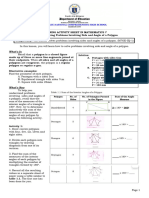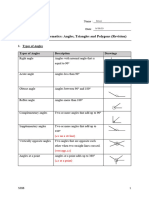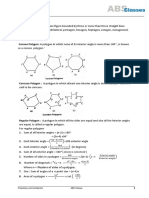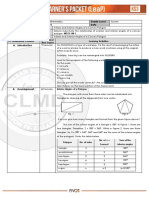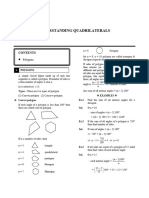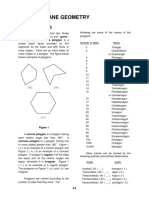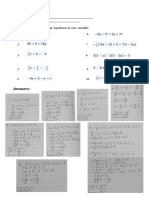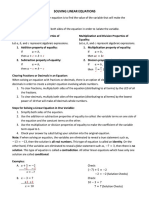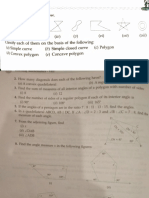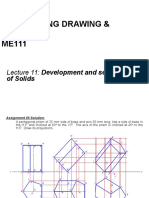Enhanced Mathematics 7
Worksheet No. 1.4 – Polygons
Name: Princess Joanah P. Mansueto Date: October 30, 2020
Grade & Section: Grade VII – Analyst Titanium
1. Which of the following are polygons? Give reasons.
B (star) because it is a close 2d shape with no intersection points.
2. How many diagonals do the following polygons have?
n(n−3) 6 (6−3) 6(3) 18
(a) Regular Hexagon = = = = = 9
2 2 2 2
n(n−3) 4(4−3) 4(1) 4
(b) Quadrilateral = = = = =2
2 2 2 2
n(n−3) 8 (8−3) 8(5) 40
(c) Octagon = = = = =20
2 2 2 2
n(n−3) 3( 3−3) 3(0) 0
(d) Triangle = = = = =0
2 2 2 2
n(n−3) 4(4−3) 4(1) 4
(e) Convex quadrilateral = = = = = =2
2 2 2 2
n(n−3) 5( 5−3) 5 (2) 10
(f) Pentagon = = = = = =5
2 2 2 2
3. Draw a regular hexagon. Join any three of its vertices and draw a triangle. Name the triangle obtained.
J O ∠ONP
� A N
H P
4. What is a regular polygon? Write the names of regular polygons having
A regular polygon is a polygon that it’s side has the same length or measure.
(a) 3 sides - Triangle
(b) 4 sides - Quadrilateral
(c) 5 sides - Pentagon
5. What can you say about the angle sum property of a convex polygon having:
(a) 9 sides – If you subtract the number of sides of the polygon which is 9 into 2, you’ll get 7 and you
need to multiply it to 180° and the product of it is 1260° therefore 1260° is our angle sum property.
(b) 7 sides – If you subtract the number of sides of the polygon which is 7 into 2, you’ll get 5 and you
need to multiply it to 180° and the product of it is 900° therefore 900° is our angle sum property.
(c) 10 sides - If you subtract the number of sides of the polygon which is 10 into 2, you’ll get 8 and you
need to multiply it to 180° and the product of it is 1440° therefore 1440° is our angle sum property.
(d) 12 sides - If you subtract the number of sides of the polygon which is 12 into 2, you’ll get 10 and you
need to multiply it to 180° and the product of it is 1800° therefore 1800° is our angle sum property.
6. Find each interior angle in a regular polygon of
( n−2 ) 180 ( 7−2 ) 180 ( 5 ) 180 900
(a) 7 sides = = = = = 128.57°
n 7 7 7
( n−2 ) 180 ( 10−2 ) 180 ( 8 ) 180 1440
(b) 10 sides = = = = = 144°
n 10 10 10
( n−2 ) 180 ( 16−2 ) 180 ( 14 ) 180 2520
(c) 16 sides = = = = = 180°
n 16 16 16
( n−2 ) 180 ( 21−2 ) 180 ( 19 ) 180 3420
(d) 21 sides = = = = = 162.85°
n 21 21 21
7. Find the number of sides of a polygon, the sum of whose interior angle is:
�(a) 1440
(b) 1080°
(c) 1800°
(d) 1260°
(e) 2340°
8. Find the number of sides of a polygon whose each interior angle is:
180° ( n−2 )
(a) 165° = =165°
n
180° (n-2) = 165°
180° - 360°n = 165°n
180° - 165°n = 360°
15n = 360°
n = 24
( n−2 ) 180 °
(b) 135° = =135°
n
(n-2) 180° = 135°n
180° - 360° = 135°n
180° - 135° = 360°
45n = 360°
n = 8
( n−2 ) 180 °
(c) 140° = = 140°
n
(n-2) 180° = 140°n
180°- 360° = 140°n
180°- 140° = 360°
40°n = 360°
( n−2 ) 180 °
(d) 162° = =162
n
(n-2)180° = 162°n
� 180°n – 360° = 162°n
180°n – 162° = 360°
18n = 360°
n = 20
( n−2 ) 180 °
(e) 108°= =108°
n
(n-2)180° = 108°n
180°n – 360° = 108°n
180°n – 108° = 360°
72n = 360°
n = 5
9. Each polygon is divided into a number of triangles. Find the number of triangles if the number of sides
in a polygon is:
(a) 6
(b) 10
(c) 15
(d) 19
(e) 23
10. Find the sum of measure of interior angles of the following polygons having:
(a) 8 sides
180° (8-2) =180° (n-2)
= 180° (6)
= 1080°
(b) 13 sides
180° (n-2) = 180° (13-2)
=180° (11)
� = 1980°
(c) 17 sides
180° (n-2) = 180° (17-2)
= 180° (15)
= 2,700°
(d) 21 sides
180° (n-2) = 180° (21-2)
= 180° (19)
= 3420°
11. Calculate the sum of the interior angles of a regular polygon with:
(a) 12 sides
(n-2) 180°
(12-2) 180°
(10) 180°
1800°
(b) 15 sides
(n-2) 180°
(15-2) 180°
(13) 180°
2340°
(c) 20 sides
(n-2) 180°
(20-2) 180°
3240°
(d) 10 sides
(n-2) 180°
�(10-2) 180°
(8) 180°
1440°
12. Find the measure of each interior angles of a regular polygon having:
(a) 6 sides
= (n -2) 180°
(6-2) 180°
(4) 180°
680°
(b) 10 sides
= (n -2) 180°
(10 -2) 180°
(8) 180°
1440°
(c) 16 sides
= (n-2) 180°
(16-2) 180°
(14) 180°
2480°
(d) 25 sides
= (n-2) 180°
(25 – 2) 180°
(23) 180°
4140°
13. Find the number of sides of the polygon if sum of the measure of the interior angle is:
(a) 1800°
�(b) 4500°
(c) 2880°
(d) 1080°
(e) 900°
(f) 2340°
(g) 3420°
14. Find the number of sides of the regular polygon if the measure of each interior angle is:
180° (n−2) 180 ° (60 °−2) 180 ° (58 ° ) 10440 °
(a) 60° = = = = =5220°
2 2 2 2
180° (n−2) 180 ° (135−2) 180° (133) 23940°
(b) 135° = = = = =11970 °
2 2 2 2
180° (n−2) 180 ° (108 °−2) 180 ° (106 ° ) 19080 °
(c) 108° = = = = =9540 °
2 2 2 2
180° (n−2) 180 ° (156 °−2) 180 ° (154 ° ) 27720°
(d) 156° = = = = =13860 °
2 2 2 2
180° (n−2) 180 ° (165 °−2) 180 ° (163 °) 29340 °
(e) 165° = = = = =14670°
2 2 2 2
180° (n−2) 180 ° (120 °−2) 180 ° (118 ° ) 21240 °
(f) 120° = = = = =10620 °
2 2 2 2
180° (n−2) 180 ° (140 °−2) 180 ° (138 °) 24840 °
(g) 140° = = = = =12420°
2 2 2 2
180° (n−2) 180 ° (160−2) 180 ° (158° ) 28440 °
(h) 160° = = = = =14220 °
2 2 2 2










